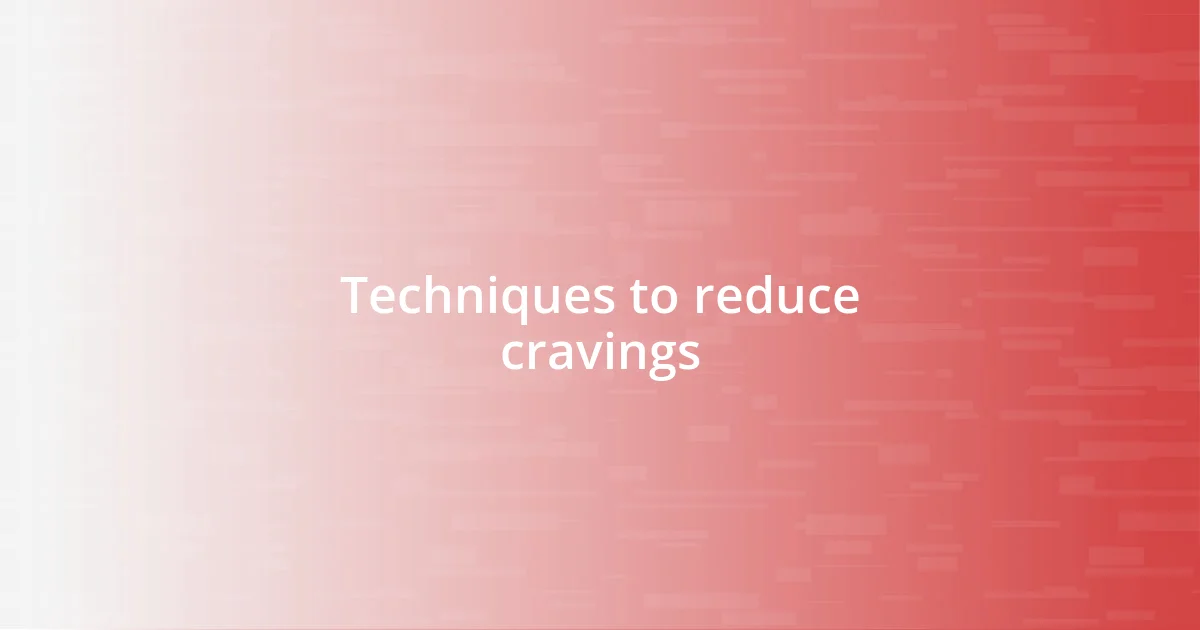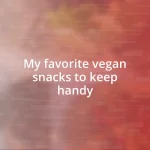Key takeaways:
- Cravings are often triggered by emotional states, habits, and social environments, rather than genuine hunger.
- Techniques such as mindful eating, hydration, and engaging in distractions can effectively reduce cravings.
- Keeping a cravings journal helps identify patterns and emotional triggers, empowering individuals to make healthier choices.

Understanding cravings triggers
Craving triggers often stem from emotional states or environmental cues. I remember a particularly stressful week when I found myself reaching for snacks every evening. It made me wonder, how often do we associate comfort with food during challenging times? Recognizing this pattern helped me realize that my cravings were less about hunger and more about seeking solace in familiar treats.
Another significant trigger for cravings can be tied to habits and routines. For example, I used to crave sweets every time I settled down on the couch for my favorite TV show. This ritual created a mental association between relaxation and indulgence. It prompts me to rethink: how many of our cravings are linked to ingrained habits that offer a sense of comfort rather than genuine hunger?
Interestingly, social settings can also intensify cravings. I recall a gathering where everyone was indulging in a lavish spread of appetizers. Suddenly, I found my eyes wandering toward the cheese platter, despite having just eaten. How often do we find ourselves craving something simply because others are enjoying it? By understanding these triggers, I’ve learned to navigate social situations more mindfully, deciding when to indulge and when to hold back.

Techniques to reduce cravings
I’ve discovered several techniques that really help diminish those pesky cravings. One effective strategy for me is to stay hydrated. I’ve often mistaken thirst for hunger, leading me to snack unnecessarily. A simple glass of water or herbal tea can quench that false hunger and give a sense of fullness.
Here are some techniques that I find to work well:
- Mindful Eating: When I slow down and really focus on my meals, I find I’m less likely to crave extras later on.
- Healthy Substitutes: Swapping out high-calorie snacks for fruit or nuts has made a world of difference. I recently replaced my evening chips with almonds and found I felt much more satisfied.
- Regular Meals: I make it a point to eat balanced meals at regular intervals. This stability keeps those cravings in check.
- Distraction: When cravings hit, I try to engage in a quick activity like taking a walk or reading a few pages of a book. It’s surprising how a little distraction can shift my focus and reduce the urge.
- Support System: I often share my goals with friends. They hold me accountable, and when cravings strike, reaching out to them really helps me resist temptation.
Every one of these techniques helps me keep cravings at bay, allowing me to feel more in control of my choices.

Foods that satisfy cravings
I’ve found that certain foods can genuinely satisfy cravings without leading me astray. For instance, I often reach for Greek yogurt when I crave something creamy and rich. It’s packed with protein and can be enhanced with fruits or a drizzle of honey. This combination not only satisfies my sweet tooth but also keeps me feeling full for longer, which is a win-win in my book.
Another go-to for me is dark chocolate. I’ve learned that a small piece can curb a strong craving for sweets. It provides that decadent feeling without the dialed-up sugar levels of regular candy. I distinctly remember one evening when a tough day at work had me longing for a sugary fix. Just a square of dark chocolate settled my cravings and lifted my mood. It felt indulgent without the guilt.
When the salty cravings hit, popcorn has become my savior. I love air-popped popcorn seasoned with a sprinkle of nutritional yeast or spices for flavor. It’s a satisfying crunch that gives me the mouthfeel I yearn for without overloading on calories. It was during a movie night that I realized how fulfilling this snack can be, keeping cravings at bay while indulging in the cinema experience.
| Type of Craving | Satisfying Food |
|---|---|
| Sweet Cravings | Greek Yogurt with Honey |
| Chocolate Cravings | Dark Chocolate |
| Salty Cravings | Air-Popped Popcorn |

Mindfulness and cravings management
Mindfulness plays a crucial role in managing cravings for me. I’ve found that when I truly focus on the flavors and textures of my food, it transforms the eating experience and reduces my desire for extra snacks. Have you ever noticed how engaging your senses can make a meal more satisfying? It’s astonishing how just being present during mealtime can lead to a deep sense of fulfillment.
When cravings creep in, I practice mindfulness techniques like deep breathing or a short meditation session. This helps center my thoughts and brings my awareness back to my body’s true needs. I remember one instance where a sudden urge for sweets hit me in the afternoon. Instead of immediately rushing for the candy jar, I took a few moments to breathe deeply and reflect. Strangely enough, this short pause allowed me to tune into my body and realize I was simply bored, not hungry.
Journaling has also become a part of my mindfulness practice. By jotting down my feelings and what triggers certain cravings, I gain valuable insights into patterns I might not consciously recognize. It’s a bit like having a heart-to-heart with myself; I uncover the emotional connections tied to my cravings. It’s really eye-opening to see how stress or even happiness can lead me to reach for snacks—and being aware of these triggers helps me effectively navigate them. So, what if we embraced these small mindful moments to better understand our cravings? I believe they can empower us to make healthier choices.

Behavioral strategies to avoid cravings
One effective behavioral strategy I’ve adopted to avoid cravings is creating a structured eating schedule. I’ve found that when I stick to regular meal times, my body starts to recognize these patterns. It’s almost like training my appetite—sticking to those times means cravings don’t have the same power over me. Have you ever noticed how unpredictability in eating can lead you to snack more? I can certainly vouch for this.
Another tactic I rely on is surrounding myself with distractions. When a craving strikes, I often take a short walk or dive into a quick task, like tidying up a room. The physical activity helps release endorphins, and I find it much harder to focus on food when I’m engaged in something else. I remember a particularly challenging day when all I could think about was indulgent snacks. I chose to reorganize my bookshelf instead, and before I knew it, that craving had completely faded into the background.
I’ve also embraced the power of positive affirmations. When I feel cravings bubbling up, I remind myself that I have the strength to choose nourishing options. Phrases like “I choose health” resonate deeply, especially when I’m faced with temptation. It’s fascinating to see how these simple affirmations can create a shift in mindset. In those moments, I really feel empowered, almost like I’m in a duel with cravings, and I’m winning. Have you ever tried talking to yourself in this way? It truly can change your perspective!

Keeping a cravings journal
Keeping a cravings journal has been a game-changer for me. Whenever I feel that familiar tug towards a snack, I take a moment to jot down the cravings and what I was doing or feeling at that time. This practice has unveiled patterns I wouldn’t have noticed otherwise; for example, I realized that stress-triggered cravings would hit around mid-afternoon. Isn’t it interesting how often our emotions influence our choices?
As I reflect on my cravings, I also note the physical sensations accompanying them. This connection between my mind and body has taught me to ask myself, “Am I truly hungry, or is this just a habitual response?” Once, I even wrote down a craving that popped up during a stressful week at work. Crafting that entry not only gave me clarity but also helped me prioritize better self-care strategies. It’s empowering to recognize these triggers and create a game plan instead of mindlessly reaching for a snack.
Looking back at my cravings journal has been enlightening. I often find that simply acknowledging my cravings—rather than judging them—allows me to explore healthier alternatives. When I see a pattern, I can adapt and change my responses. How about you? Have you ever considered that a journal might help you understand your relationship with food and cravings better?

Long-term strategies for craving control
Long-term strategies really help in gaining control over cravings, and one approach I’ve found effective is meal prep. By preparing my meals in advance, I not only have healthier options readily available, but it also keeps me from reaching for convenience snacks. There was a time when I found myself lost in the cycle of last-minute takeout. Planning out meals has turned that around, leaving me satisfied and wandering less into impulse territory. Have you ever found yourself munching just because it was easy?
Mindfulness is another powerful tool in my arsenal. When I practice being present during meals, I savor each bite and truly appreciate flavors. I recall a night not too long ago when I sat down with my favorite dish, taking a moment to breathe in the aroma first. That simple act heightened my satisfaction and made me less inclined to snack afterward. Have you thought about how slowing down during meals might impact your cravings?
Support systems also play a crucial role in craving control. I regularly share my goals with friends, making me feel accountable for my choices. Just a week ago, I chatted with a friend who’s on a similar journey, and we encouraged each other to swap our go-to snack ideas. It’s amazing how motivating it can be to have someone cheering you on during challenging times. Have you ever reached out for support when cravings hit? It can create a sense of community that fosters healthier choices.












